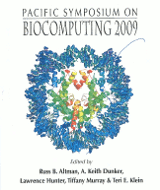Integration of Angiogenesis Modules at Multiple Scales: From Molecular to Tissue
Amina A. Qutub1, Gang Liu2, Prakash Vempati3, and Aleksander S. Popel4
1Department of Biomedical Engineering, Johns Hopkins University, School of Medicine, 613 Traylor Bldg., 720 Rutland Ave, Baltimore, MD 21205 USA; 2Department of Biomedical Engineering, Johns Hopkins University, School of Medicine, 425 Traylor Bldg., 720 Rutland Ave, Baltimore, MD 21205 USA; 3Department of Biomedical Engineering, Johns Hopkins University, School of Medicine, 613 Traylor Bldg., 720 Rutland Ave, Baltimore, MD 21205 USA; 4Department of Biomedical Engineering, Johns Hopkins University, School of Medicine, 611 Traylor Bldg., 720 Rutland Ave, Baltimore, MD 21205 USA
Pacific Symposium on Biocomputing 14:316-327(2009)

Abstract
Multiscale modeling has emerged as a powerful approach to interpret and capitalize on the biological complexity underlying blood vessel growth. We present a multiscale model of angiogenesis that heralds the start of a large scale initiative to integrate related biological models. The goal of the integrative project is to better understand underlying biological mechanisms from the molecular level up through the organ systems level, and test new therapeutic strategies. Model methodology includes ordinary and partial differential equations, stochastic models, complex logical rules, and agent-based architectures. Current modules represent blood flow, oxygen transport, growth factor distribution and signaling, cell sensing, cell movement and cell proliferation. Challenges of integration lie in connecting modules that are diversely designed, seamlessly coordinating feedback, and representing spatial and time scales from ligand-receptor interactions and intracellular signaling, to cell-level movement and cell-matrix interactions, to vessel branching and capillary network formation, to tissue level characteristics, to organ system response. We briefly introduce the individual modules, discuss our approach to integration, present initial results from the coordination of modules, and propose solutions to some critical issues facing angiogenesis multiscale modeling and integration.
[Full-Text PDF] [PSB Home Page]